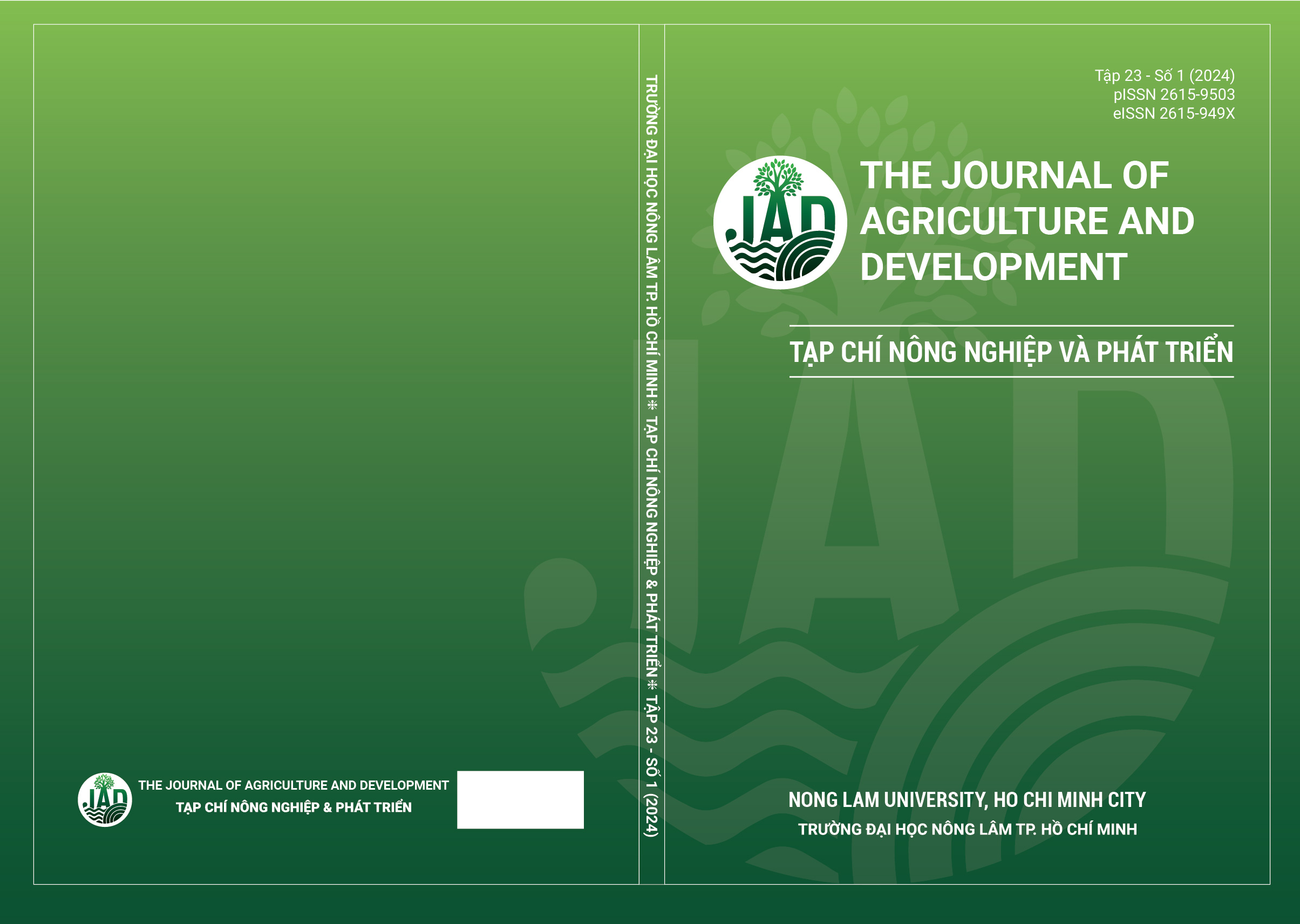Evaluation of the protective efficacy of inactivated vaccines from wild-type Streptococcus agalactiae (GBS) on red Tilapia (Oreochromis sp.)
Main Article Content
Abstract
Streptococcus agalactiae causing eye edema and haemorrhagic disease on red tilapia is a serious problem for the aquaculture industry. The experiment was conducted to evaluate the protective efficacy of formalin-inactivated S. agalactiae AG5 (Group B Streptococcus, GBS) vaccine on red tilapia (Oreochromis sp.) by feeding method. The experiment was arranged in a completely randomized design and fish were fed vaccine-mixed feeds with different concentrations of 104; 105; 106; 107; 108 CFU/g of feed, respectively. At 3 weeks after being fed vaccines, fish were infected with wild-type S. agalactiae AG5 strain by injecting 100 µL of medium containing a dose of LD50 = 6.87 × 103 CFU/mL into the abdomen. The effectiveness of relative percentage survival (RPS) protection was determined within 1 week after infection. Samples of dead fish were recorded with symptoms and brain samples were cultured on TSA medium and incubated at 28oC for 24 h. The colonies were examined using PCR test with F1/IMOD-specific primer pairs. The results showed that the inactivated S. agalactiae AG5 (GBS) vaccine had the highest protective effect on red tilapia of 50% at the vaccine dose of 107 CFU/g of feed. The study also showed that red tilapia had an immune response with the mean antibody titers in the vaccine treatments, ranging from 2.24 ± 0.20 to 3.59 ± 0.42 (P < 0.05).
Article Details
References
Amend, D. F. (1981). Potency testing of fish vaccines. Developments in Biological Standardization 49, 447-454.
Baxter, D. (2007). Active and passive immunity, vaccine types, excipients and licensing. Occupational Medicine 57(8), 552-556. https://doi.org/10.1093/occmed/kqm110.
Biering, E., Villoing, S., Sommerset, I., & Christie, K. E. (2005). Update on viral vaccines for fish. Developments in Biologicals 121, 97-113.
Caipang, C. M. A., Brinchmann, M. F., & Kiron, V. (2009). Profiling gene expression in the spleen of Atlantic cod, Gadus morhua upon vaccination with Vibrio anguillarum antigen. Comparative biochemistry and physiology. Comparative Biochemistry and Physiology Part B: Biochemistry and Molecular Biology 153(3), 261-267. https://doi.org/10.1016/j.cbpb.2009.03.005.
Channarong, R., Pattanapon, K., Nopadon, P., & Janenuj, W. (2012). Duplex PCR for simultaneous and unambiguous detection of Streptococcus iniae and Streptococcus agalactiae associated with Streptococcosis of cultured Tilapia in Thailand. Thai Journal of Veterinary Medicine 42(2), 153-158.
Chen, M., Wang, R., Li, L. P., Liang, W. W., Li, J., Huang, Y., Lei, A. Y., Huang, W. Y., & Gan, X. (2012). Screening vaccine candidate strains against Streptococcus agalactiae of tilapia based on PFGE genotype. Vaccine 30(42), 6088-6092. https://doi.org/10.1016/j.vaccine.2012.07.044.
Evans, J. J., Klesius, P. H., & Shoemaker, C. A. (2004). Efficacy of Streptococcus agalactiae (group B) vaccine in tilapia (Oreochromis niloticus) by intraperitoneal and bath immersion administration. Vaccine 22(27-28), 3769-3773. https://doi.org/10.1016/j.vaccine.2004.03.012.
Giordano, L. G. P., Muller, E. E., Klesius, P., & Silva, V. G. D. (2010). Efficacy of an experimentally inactivated Streptococcus agalactiae vaccine in Nile tilapia (Oreochromis niloticus) reared in Brazil. Aquaculture Research 41(10), 1539-1544. https://doi.org/10.1111/j.1365-2109.2009.02449.x.
Hart, S., Wrathmell, A., Harris, J. E., & Grayson, T. H. (1988). Gut immunology in fish: A review. Developmental and Comparative Immunology 12, 453-480. https://doi.org/10.1016/0145-305x(88)90065-1.
Ismail, M. S., Siti-Zahrah, A., Ridzuan, M. S. M., Azmai, M. N. A., Firdaus-Nawi, M., & ZamriSaad, M. (2016). Feed-based vaccination regime against streptococcosis in red tilapia, Oreochromis niloticus x Oreochromis mossambicus. BMC Veterinary Research 12(1), 194. https://doi.org/10.1186/s12917-016-0834-1.
Le, H. V., Pham, M. T. H., Le, H. L. P., & Ngo, T. H. P. (2022). Screening antagonistic Bacillus spp. strains against Streptococcus agalactiae causing popeye and hemorrhage in Tilapia (Oreochromis sp.). Hue University of Agriculture and Forestry Journal of Agricultural Science and Technology
6(1), 2751-2761. https://doi.org/10.46826/huafjasat.v6n1y2022.796.
Le, K. M., Tu, D. T., Bui, H. T. B., Seng, E. K., Hian, S. K., Tran, H. T. T., & Dang, T. T. M. (2021). Evaluation of the immunological effectiveness of the vaccine against hemorrhagic disease caused by Aeromonas hydrophila on catfish (Pangasianodon hypophthalmus). Can Tho University Journal of Science 57(3B), 181-190. https://doi.org/10.22144/ctu.jvn.2021.100.
Ma, J., Bruce, T. J., Jones, E, M., & Cain, K. D. (2019). A review of fish vaccine development strategies: Conventional methods and modern biotechnological approaches. Microorganisms 7(11), 569. https://doi.org/10.3390/microorganisms7110569.
Mousavi, S. M., Hosseini, S. M., Mashouf, R. Y., & Arabestani, M. R. (2016). Identification of group B streptococci using 16S rRNA, cfb, scpB, and atr genes in pregnant women by PCR. Acta Medica Iranica 54(12), 765-770.
Munang’andu, H. M., Mutoloki, S., & Evensen, Ø. (2014). Non-replicating vaccines. In Gudding, G., Lillehaug, A., & Evensen, Ø. (Eds.). Fish vaccination (22-32). https://doi.org/10.1002/9781118806913.
Nakanishi, T., & Ototake, M. (1997). Antigen uptake and immune response after immersion vaccination. Developments in Biological Standardization 90, 59-68.
Nguyen, P. N., Nguyen, L. T. H., Nguyen, H. T. X., Sandra, A., Janina, Z. C., & Kim, D. T. (2019). Protection of formanlin-killed vaccine against Streptococcus agalactiae (serotype III) in Tilapia (Oreochromis sp.). Science and Technology Journal of Agriculture and Rural Development 22, 100-108.
Nguyen, U. H. N., & Dang, O. T. H. (2019). Immune responses in tilapia (Oreochromis niloticus) vaccinated with in-activated Streptococcus agalactiae vaccine. Can Tho University Journal of Science 55(4B), 123-131. https://doi.org/10.22144/ctu.jvn.2019.116.
Pham, Q. H., Ho, T. T., Nguyen, V. H., Huynh, L. T. M., & Le, K. V. (2013). Biochemical characteristics of Streptococcus spp. isolated from tilapia with hemorrhagic disease in some Northern provinces of Vietnam. Journal of Science and Development 11(4), 506-513.
Reed, L. J., & Muench, H. A. (1938). A simple method of estimating fifty percent end points. American Journal of Epidemiology 27(3), 493-497. https://doi.org/10.1093/oxfordjournals.aje.a118408.
Roberson, B. B. (1990). Bacterial agglutination. In Stolen, J. S., Fletcher, T. C., Anderson, D. P., Roberson, B. S., & van Muiswinkel, W. B. (Eds.). Techniques in fish immunology (1st ed., 1-86). New Jersey, USA: SOS Publications.
Tu, D. T., Tran, C. H., Nguyen, U. H. N., & Ma, T. L. D. (2013). The immune response ability of striped catfish (Pangasianodon hypophthalmus) against Edwardsiella ictaluri. Can Tho University Journal of Science 26, 269-276.








